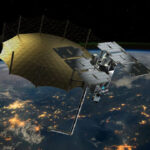May 30, 2023
ALEXANDRIA, Va. — Every so often an application comes along that shifts markets, displaces legacy technologies and even changes the way people live their lives. With mega-constellations of broadband satellites, a flood of sensor data from space and the prospects of an interconnected network from the surface of Earth to the moon, some are looking to space for the next software revolution.
But before the space world produces the “next killer app,” there’s the not-so-insignificant matter of the underlying computing infrastructure to support it.
Ramon.Space got its start in precision, space-hardened semiconductors and processors. By 2019, the Israeli firm began developing advanced computing systems that would cover the three fundamentals of handling data: storage, processing and connectivity.
“What we need to do, essentially, is to enable the infrastructure in space to look like it is on Earth,” said Avi Shabtai CEO of Ramon.Space. “Once you have the infrastructure, you can accelerate the development of applications and services.”
Just as cloud computing infrastructure on Earth laid the foundation for countless new companies and services, a similar capability in orbit could prime the space industry for significant expansion.
A Mesh Network from Earth to the Moon
Ramon.Space’s main objective is to enable “Earth-like computing” in space, Shabtai explained, which requires a combination of space-hardened hardware—processors, storage, memory—and software-defined systems to adapt to various, evolving mission needs.
When computing capacity is less of a limitation, individual satellites can engage in more intensive processes, like running AI/ML algorithms, adapting a payload mission, even crypto mining. Having a baseline computing infrastructure across a satellite network mean each junction is intelligent and capable of data processing, storage and connectivity.
Ramon.Space’s computing platforms can be deployed in different configurations, from edge processing on a single satellite to data relay between a constellation. The computing systems can also serve a data center function serving a data center function—centralized or distributed—helping meet the growing demand for intelligently interconnected satellite networks.
“It’s not just what we do on a single satellite, it’s how you build networks in space that are similar, for example, to terrestrial infrastructure,” Shabtai explained. Terrestrial networks are increasingly a mesh of billions of access points facilitating a consistent, dynamic flow of information between nodes, utilizing any number of possible pathways.
“What happens in space is really the build-out of that mesh infrastructure that can enable every point to connect to every point,” he continued. Whether it’s an edge device on Earth, a satellite in orbit or a lunar communication outpost, each point becomes part of a content and data deliver network. “Once this is enabled, I think it will really change the space industry.”
Read the full article: https://www.kratosdefense.com/constellations/articles/bringing-earth-like-computing-infrastructure-to-space






